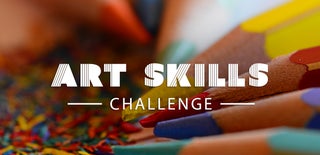Introduction: Woodburning: Floral Coasters
I didn't think there were enough Instructables for this sort of thing, so I decided to make my own.
Supplies
To make a set of six coasters you will need:
- one woodburning tool, with a variety of points if possible. (Though I've seen an instructable using a soldering iron.)
- Pliers for changing the points. (Mine came from a jewelry making kit)
- 6 flat wooden shapes (I used circles, but any simple shape will work)
- Sandpaper
- The image(s) you want to transfer. This could be a stencil, as shown, or a printed image. Or you could free-hand something.
- A Pencil. (If you printed your image, Carbon paper and a pen)
Step 1: Prep-work
Sand down any rough spots on the wooden circles. This is also your chance to revise any other shapes, rounding off corners or beveling edges if you'd like.
Step 2: Stenciling
If your chosen image is too big to fit in the circle, figure out which parts you want to show, and line up the image or stencil accordingly. If you're using a stencil, place it directly on the wooden surface. If you've printed out your design, place the carbon paper on the surface, and the design on top of that. (Be careful not to press down once the carbon paper is in place, or you'll transfer extra marks to the surface below.)
Start by tracing out the outside edges, so that you can line it up again if it moves. Keep tracing until you have the entire design transferred onto the coaster-to-be.
Step 3: Pick Your Points
The detail point shown above usually ends up being the one I use the most, especially for smaller projects like this. A simpler image with bolder lines might be easier to draw with one of the broader points.
Just remember, this is a woodburning tool. The one I have heats up to 750 degrees F. Don't poke anything you don't want burned, like fingers or plastic. Don't grab the metal bit either. And give it plenty of cooling time before you change the points or put it away.
The pliers are a necessary tool here. Not only do they help you get a better grip on the points (they're rather small, and very smooth), but they keep your fingers away from any metal that isn't quite as cooled off as you thought it was.
If you aren't sure what sort of mark a point makes, test it out on a scrap piece before using it on a project. I like to use cheap craft sticks for this, and for temperature checks.
Step 4: Time to Burn
Once you've chosen a point, turn the woodburner on and let it heat up. This takes about five minutes, for the one I have. Might be faster or slower depending on the room temperature, drafts or fans blowing across the work area, or temperature settings on some of the fancier models. Poke one of your scraps to test it.
Begin tracing the marks you made back in Step 2. Make sure to keep the tooltip moving, and to use a light touch, especially with the finer points. They might bend at higher temperatures if you press too hard. And any point kept still or pressed down will leave a much larger, darker mark than normal, and might even burn right through a thin piece of wood.
Once you've gotten into a rhythm, tracing out the entire design is surprisingly quick, even with breaks to let the tool heat back up (the finer points tend to lose heat faster than the broad ones). I used those breaks to prep the other coasters, and start work on my next project.
Step 5: Second Stencil
This one had less detail to it than the first, so I used the mini-flow point for the lines. I also used it to fill in any smaller areas that I wasn't sure the Flow point would fit into.
Then it was just a matter of filling in anything that was left with the flow point.
For this one especially, I spent more time waiting for the tool to heat up or cool down than I did for the actual burning.
Step 6: Experiments With the Shading Point
I drew this one free-hand, not basing it on any one type of flower. I then decided that I wanted something to contrast with the mostly light-colored ones in the set.
So, despite only having used the shading point twice before (once on another coaster in this group, and again on another project), I went ahead and 'shaded' the entire background, adding details afterwards with the detail point.
I learned 4 things with this one:
- The flat side of the shading point isn't actually flat, so it's harder to judge where you're burning
- It holds heat wonderfully
- It makes a little more smoke than the other points, so I had to open the window or fear the wrath of the nearest smoke detector
- And last, but certainly not least, I need more practice with that one.
But I do like the way it turned out, so I plan to do more like it.
Step 7: Finished Coasters, in Pairs
No instructions here, just a few shots of the finished set, in case the main image didn't have enough detail. I made two from the first stencil, one with any enclosed area filled in and another with just the outlines.
I might go back and add a layer of thinned acrylic paint later, but that would likely require a waterproof layer over the top if they get used as coasters.

Participated in the
Art Skills Challenge







